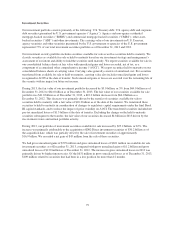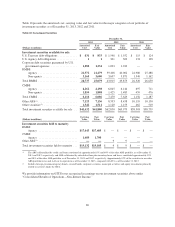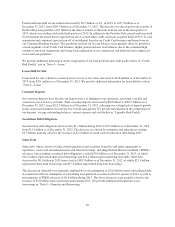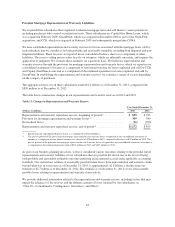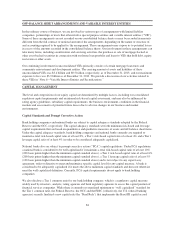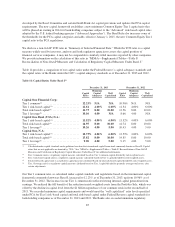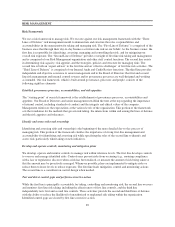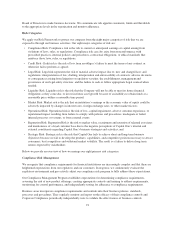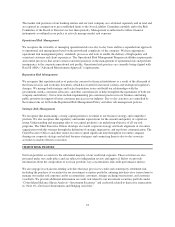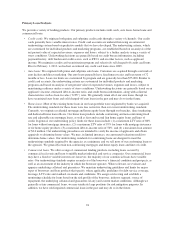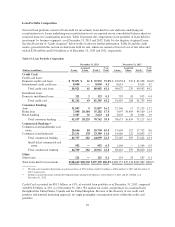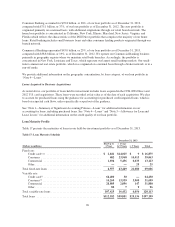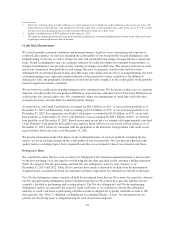Capital One 2013 Annual Report Download - page 107
Download and view the complete annual report
Please find page 107 of the 2013 Capital One annual report below. You can navigate through the pages in the report by either clicking on the pages listed below, or by using the keyword search tool below to find specific information within the annual report.
Table 15: Estimated Common Equity Tier 1 Capital Ratio Under Basel III Standardized
December 31, 2013
(Dollars in millions, except ratio) 2014 Phase-In 2015 Phase-In Full Phase-In
Tier 1 common capital under Basel I rules .................... $ 27,487 $ 27,487 $ 27,487
Adjustments related to AOCI for securities available for sale and
defined benefit pension plans(1) ......................... (175) (350) (875)
Adjustments related to PCCR intangible(1) .................. (134) (402) (1,207)
Other adjustments(1)(2) ................................... 305 230 5
Estimated Common Equity Tier 1 capital under Basel III
Standardized ........................................... $ 27,483 $ 26,965 $ 25,410
Risk-weighted assets under Basel I rules ...................... $224,671 $224,671 $224,671
Adjustments for Basel III Standardized(3) ................... 210 7,979 7,805
Estimated risk-weighted assets adjusted for Basel III
Standardized ........................................... $224,881 $232,650 $232,476
Estimated Common Equity Tier 1 capital ratio under Basel III
Standardized(4) ......................................... 12.2% 11.6% 10.9%
(1) Adjustments are phased in at 20% for 2014, at 40% for 2015, and at 100% for 2018 and beyond.
(2) Other adjustments are related to disallowed deferred tax assets from net operating losses and tax credit carry forwards, mortgage
servicing rights and other intangibles net of associated deferred tax liabilities.
(3) Adjustments to Basel I risk weighted assets include higher risk weights for 90 days or more past due exposures, high volatility
commercial real estate, securitization exposures and corresponding adjustments to PCCR intangibles, deferred tax assets and certain
other assets in the calculation of Common Equity Tier 1 capital under Basel III Standardized.
(4) Calculated by dividing Estimated Common Equity Tier 1 capital under Basel III Standardized by estimated risk-weighted assets
adjusted for Basel III Standardized.
With respect to the Basel III Advanced Approaches, we expect to enter the parallel run phase no earlier than
January 1, 2015. We currently anticipate a multi-year parallel run consistent with the experience of other U.S.
banks. By rule, this phase must last at least four consecutive quarters.
Under the Final Rule, when we complete our parallel run for the Advanced Approaches, our minimum risk-based
capital requirement will be the greater requirement of the Basel III Standardized and the Basel III Advanced
Approaches. We anticipate that we will need to hold more regulatory capital under the Basel III Advanced
Approaches than under Basel I or Basel III Standardized to meet our minimum required capital ratios.
Capital Planning and Regulatory Stress Testing
In November 2011, the Federal Reserve finalized capital planning rules applicable to large bank holding
companies like us (commonly referred to as “Comprehensive Capital Analysis and Review” or “CCAR”). Under
the rules, bank holding companies with consolidated assets of $50 billion or more must submit capital plans to
the Federal Reserve on an annual basis and must obtain approval from the Federal Reserve before making most
capital distributions. The purpose of the rules is to ensure that large bank holding companies have robust,
forward-looking capital planning processes that account for their unique risks and capital needs to continue
operations through times of economic and financial stress.
On September 24, 2013, the Federal Reserve released an interim final rule that stated, for the first time, that the
2014 CCAR cycle will require us to meet Basel III Standardized capital requirements, with appropriate phase-in
provisions applicable to Advanced Approaches institutions during the CCAR planning horizon, under the
supervisory severely adverse stress scenario in addition to the capital plan rule’s Tier 1 common ratio using Basel
I definitions. See “Recent Developments in Capital Requirements” above for more information regarding Basel
87




